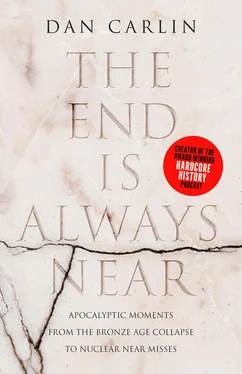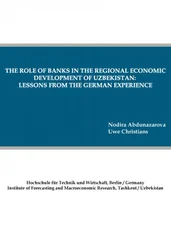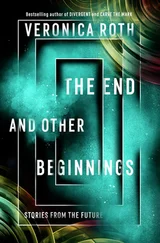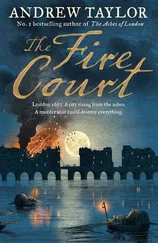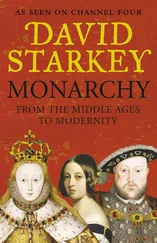Perhaps how long any societal, economic, or civilizational downturn lasts is a key factor in whether or not we agree that something qualifies as a dark age. Both the Great Depression in the United States in the 1930s and the post-Soviet breakup of the 1990s lasted roughly a decade or so. That length hardly seems to meet the minimum standard for a dark age. However, had the direct fallout from either instead lasted a century or two, that might have been enough to turn a statistical civilizational blip into an extended negative trend.
One of the modern theories on societal collapse argues that because of the entire planet’s connected nature in the twenty-first century, individual or localized “dark ages” of the sort that formerly occurred are nowadays absorbed by the rest of the global body and civilization as a whole. [53]Others have suggested that the depth and severity of any potential “dark age” are lessened due to modern interconnectivity. So you might have another Great Depression or the fall of a superpower, but you won’t have a century of global decline and technological backsliding. It’s sort of a global diversification of risk in our modern civilization, a redundancy that allows the system to survive local blackouts.
But perhaps our bias is showing. Maybe such changes are not decline or backsliding at all. It all might depend on the criteria we’ve decided to use. Depending on your point of view, things might not be considered better or worse … just different .
Earlier we brought up the idea of “progress” having an innate bias attached to it. If literacy declines in a later era because reading is less important, is this indicative of living in a “dark(er) age”? Or would it be more a case of people adjusting their skills based on their needs? And who gets to decide this—we moderns looking backward at the past, or the people actually living in the earlier era? Our ideas of what was good for the inhabitants of an earlier time might be different from their own.
This brings up the question of how much the people living in a dark age would even realize it. If you were born in Greece in 1000 BCE, [54]did you know (or care) that there was a greater age before yours? Take a kid born in the United States in 1929, at the beginning of the Great Depression. On his tenth birthday, the world was still mired in the effects of the crash. To that child, the privation and lowered sense of expectations felt normal; he had no experience or memory of anything else. His parents, however, likely felt that times had gotten tougher. While it sounds like a bad thing to be living in a society off its technological, cultural, or economic highs, it’s very possible the happiness level of individual human beings adjusted and evened out comparatively quickly. It’s hard to know what you’re missing after it’s been gone for a couple of lifetimes.
Maybe we are looking at this entirely wrong. If we lived in an era when our history books taught us that Ben Franklin’s eighteenth-century Revolutionary War generation had landed a spacecraft on Mars and could completely cure cancer (which of course we can’t do or haven’t done yet), would we care? Of course we would want the things of the past that seemed like improvements, but would we want the rest of the package that came along with it? If, for example, a Native American from five centuries ago had a bad tooth, she might really want our modern dentistry to deal with it. But if in order to get the modern medicine she had to become modern in all the other aspects of her existence, she might not consider the deal worth it.
There are multiple ways that any account or story can be viewed, but it’s helpful to be reminded from time to time. Certain narratives, such as “golden ages” and “rise and falls,” are so ingrained in our thinking that it’s easy to forget there might be other ways to see things. The anthropologist Joseph Tainter said that in some regions the Roman Empire taxed its citizens so highly, and provided so few services in return, that some of those people welcomed the “conquering barbarians” as liberators.
A similar theory exists about the Bronze Age: that perhaps the very bureaucratic and tax-heavy structure of the palace cultures of the Mediterranean states stopped working well for the majority of people, and one way or another they abandoned or stopped actively supporting it. In such a case, if things become too complicated to work well, or too centralized to be in touch with ground-level problems, is reverting to a greater level of simplicity and local control moving in a negative or a positive direction? [55]
As with so many things, it may depend on whom you ask. No doubt at least some of those living back then would think we were romanticizing how wonderful the “good old days” of their lives were. Indeed, the successors of Rome would spend hundreds of years trying to put it back together again (in some form or another), and a certain blind poet named Homer would make a living recalling tales of the good old heroic days of the Bronze Age centuries after it ended.
TWENTY-ONE YEARS AFTER Planet of the Apes was released, at an excavation of the city of Mosul in northern Iraq, archaeologists from the University of California began slicing into what, to the naked, untrained eye, appeared to be a naturally occurring hill. But like so many other mounds in the area, it was actually a man-made stone-and-brick structure that the passing of thousands of years had worked to transform. Underneath twenty-five centuries’ worth of dirt, evidence of disaster was revealed: a layer of destruction and burnt material just beneath the soil. Pieces of weapons were discovered, and a corridor of sorts emerged, with cut stonework and a pebbled floor.
Then the archaeologists found the dead.
There were at least twelve skeletons in the passage, multiple adults and children, and also a horse. The bodies appeared to lie where they had fallen. There was no indication of looting, which in any case would have been difficult, because at or near the time of these people’s death, the corridor had collapsed and buried them. Investigators determined the roof had been burning when it fell, and some of the dead were scorched before they expired on that terrible day two and a half millennia ago.
Had the site been discovered closer to the time of the events, the findings would have been grisly in the extreme, but time has a way of sanitizing even a mass killing. There is no longer any flesh or blood or viscera, and the facial expressions have been erased by decay.
The Halzi Gate, as the site was later identified, was one of fifteen external openings in the walled defenses of perhaps the greatest urban center of the ancient world—Nineveh, the heart of the Assyrian Empire in northern Mesopotamia.
At its height, around 650 BCE, the city and its surrounding villages may have had as many as 150,000 inhabitants and covered an area of about two thousand acres, or just under three square miles. The city was a wonder of its age, huge and grand, the center of gravity of the Assyrian Empire’s government and the primary residence of its ruler, a figure whose many self-proclaimed titles included “king of the universe.” The defenses of this metropolis were mammoth, with walls sixty feet tall and fifty feet thick stretching more than three miles on each side, and deep ditches carved out below them. The Halzi Gate itself had a 220-foot-tall facade and was flanked by six towers.
Yet in the same way the ash-covered corpses from the Roman-era volcanic destruction of Pompeii are frozen in the moment of their death, the dead at the Halzi Gate are frozen in the instant of their final agony. The bodies show the unmistakable signs of mortal hand-to-hand combat, including defensive wounds and, in some cases, clear evidence that a final killing blow was administered. They died as their city was dying.
Читать дальше
